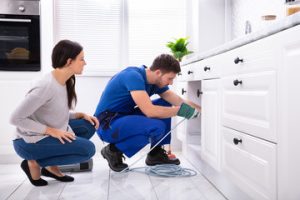Sacramento Cabinet Refacing is a popular way to update your kitchen without having to undertake a full-scale remodel. However, it’s important to consider the different materials that are available for refacing.

Solid wood is an elegant option that can add luxury and value to your home. But it’s not as durable as other options and can show signs of wear quickly.
The cost of cabinet refacing depends on several factors, including the type of material used and the amount of work involved. Higher-end materials like natural wood veneers or custom laminates may be more expensive than standard thermofoil or laminate options. The size of the kitchen and the number of cabinets also affects the overall cost of the project. In addition, any customizations or specialized hardware will increase the cost. A professional cabinet refacing contractor will work with you to find the right solution for your budget.
Refacing is a great option for homeowners who want to update their kitchen without the expense of replacing the existing cabinets. The process is also environmentally friendly and saves old cabinets from being sent to a landfill. In addition, refacing is much less labor-intensive than installing new cabinets and requires no demolition or structural changes to the kitchen.
However, refacing is not a magic fix for outdated or damaged cabinets. If you have underlying issues with your cabinets, such as water damage or mold, these need to be addressed before you consider refacing. Otherwise, you could end up with beautiful new cabinet fronts attached to deteriorating frames. If you are dreaming of a completely new kitchen layout, refacing is not the best option for you and a full remodel may be necessary.
A major advantage of cabinet refacing is that it can be completed in half the time of a complete kitchen remodel. This is because it does not require demolition or the installation of new walls and flooring, which makes it a more cost-effective alternative to full replacement.
While refacing is less costly than replacing cabinets, it is not an inexpensive renovation by any means. The key is to choose a trusted contractor who can deliver a high-quality result within your budget. The team at Redo Cabinets will work with you to create a plan that is customized to your specific needs and provides the results you deserve.
A quality cabinet refacing project can last 10-15 years, similar to that of new stock or semi-custom cabinets. This longevity is largely due to the quality of the original cabinet boxes and the installation process. Unforeseen issues can occur during the refacing process, but it is important to address these quickly and efficiently to ensure a long-lasting finish.
Durability
The durability of your cabinet refacing project depends on the type of material used. Low-quality materials will show wear and tear more quickly than high-quality materials. If you want your refacing to last, make sure that you choose quality materials and have them installed by a professional. The longevity of your cabinets will also depend on how often you use them and how much moisture they are exposed to.
Wood veneer is a popular choice for cabinet refacing, and it is available in a variety of wood finishes. It is easy to apply and comes with a paper backing, making it easier to work with. This allows for a seamless appearance and reduces the risk of peeling or lifting over time. However, wood veneer can be vulnerable to water damage and warping. It also may not withstand heat well.
Plywood with a veneer core is another good option for cabinet refacing. It is strong and stable, making it a great choice for face frames and larger surfaces. It is also resistant to heat and moisture, but it is not as durable as solid wood.
Another option is to use paintable laminate. This 0.15″-thick refacing material is durable and can be painted with a wide range of colors. It can be installed with either non-adhesive or pressure-sensitive adhesive. It is recommended that you use a veneer-smoothing tool to ensure a smooth surface for painting.
Rigid thermofoil, or RTF, is the latest cabinet refacing material to hit the market. It consists of a fiberboard substance bonded with a flexible vinyl layer under pressure. The result is a durable, versatile product that can mimic the look of real wood tones and granite. Thermofoil is resistant to mold, moisture, and heat, and offers a wide variety of color and texture options.
One of the most important factors to consider when choosing a cabinet refacing contractor is their experience and skill. A qualified contractor will be able to properly prepare the cabinet boxes for refacing, and they will take the time to install the new material carefully and evenly. They will also be able to match the color and finish of the new material with your existing kitchen. In addition, a skilled contractor will be able to install the new door hinges and drawer pulls correctly.
Appearance
Cabinet refacing is a popular way to give your kitchen a new look without investing in a full renovation. It involves removing existing drawer fronts and cabinets doors, cleaning and preparing the frames, and applying a veneer to them. The appearance of refacing is far more appealing than traditional painting, and it can add significant value to your home. However, it is important to choose the right type of finish for your refacing project. This will determine the durability and longevity of your cabinets.
A lower-end option for cabinet refacing is to use wood veneer. This material can make your cabinets look nice, but it is not as durable as solid wood and it has a fake texture that can give your kitchen an unfinished feel. Also, it is more susceptible to moisture damage, as it cannot withstand the harsh environment of your home.
High-end options for refacing include solid and laminate wood, which both offer excellent durability. Solid wood is more expensive, but it will provide a more natural and luxurious look that can enhance your home’s value. Laminate wood is more affordable and comes in a variety of styles, colors, and finishes. It is also easy to clean, making it an ideal choice for families with children or pets.
Another disadvantage of refacing is that it limits customization compared to new cabinet installations. This restriction prevents homeowners from achieving their design goals and incorporating modern features into the cabinets. In addition, it may lead to structural issues such as sagging shelves and weak joints. This can significantly decrease your storage space and hinder the functionality of your cabinets.
Choosing new cabinets from NextDAY Cabinets Chantilly Showroom provides a more long-term solution to your kitchen or bathroom storage needs. In addition to improved aesthetics and durability, new cabinets will address hidden problems and improve the structural integrity of your cabinets, increasing the overall functionality of your space. Moreover, this investment will save you money in the long run as it will reduce future renovation costs. New cabinet installation also utilizes better construction techniques and materials, which will increase the longevity of your cabinets and add to your home’s resale value.
Time
While the exact amount of time it takes to complete Cabinet Refacing will vary depending on the project, it typically only requires 2-4 days from start to finish. This makes it a great option for homeowners who want to update their kitchen without undergoing a major renovation. In addition, refacing is less expensive than replacing cabinets and is more environmentally friendly.
When choosing a contractor to handle your Cabinet Refacing, it is important to choose one with extensive experience in the field. This will ensure that the project is completed correctly and that any issues will be handled efficiently. A qualified contractor will also be able to recommend additional upgrades that may improve your home’s appearance and functionality.
Before the work begins, your cabinet refacing installer will remove all existing drawer and cupboard doors as well as their hardware. They will then prep the area by cleaning it thoroughly and lightly sanding the cabinet frames and doors. This will allow the new veneers and cabinet skins to adhere properly.
Once the new cabinet doors are installed, any remaining surfaces can be stained or painted. This includes the inside of the cabinets, the bottom of the cabinet boxes, and any other visible areas. This will create a completely new look and feel to your space, and will make it more cohesive and attractive. The use of Bendheim Cabinet Glass inserts is an excellent way to add visual interest to your kitchen and make it more modern.
When hiring a professional to complete your Cabinet Refacing, be sure to ask about their warranty. A reputable company will offer a lifetime warranty on their materials and workmanship. This will give you peace of mind that your investment is protected.
Cabinet refacing is an excellent way to add a fresh, updated look to your kitchen and increase its value. It is more cost-effective and durable than traditional refinishing and lasts as long as brand new cabinets. In addition, refacing is an eco-friendly option as it eliminates waste and reduces landfills. It also offers a wider range of style options for your home than a complete remodel.


